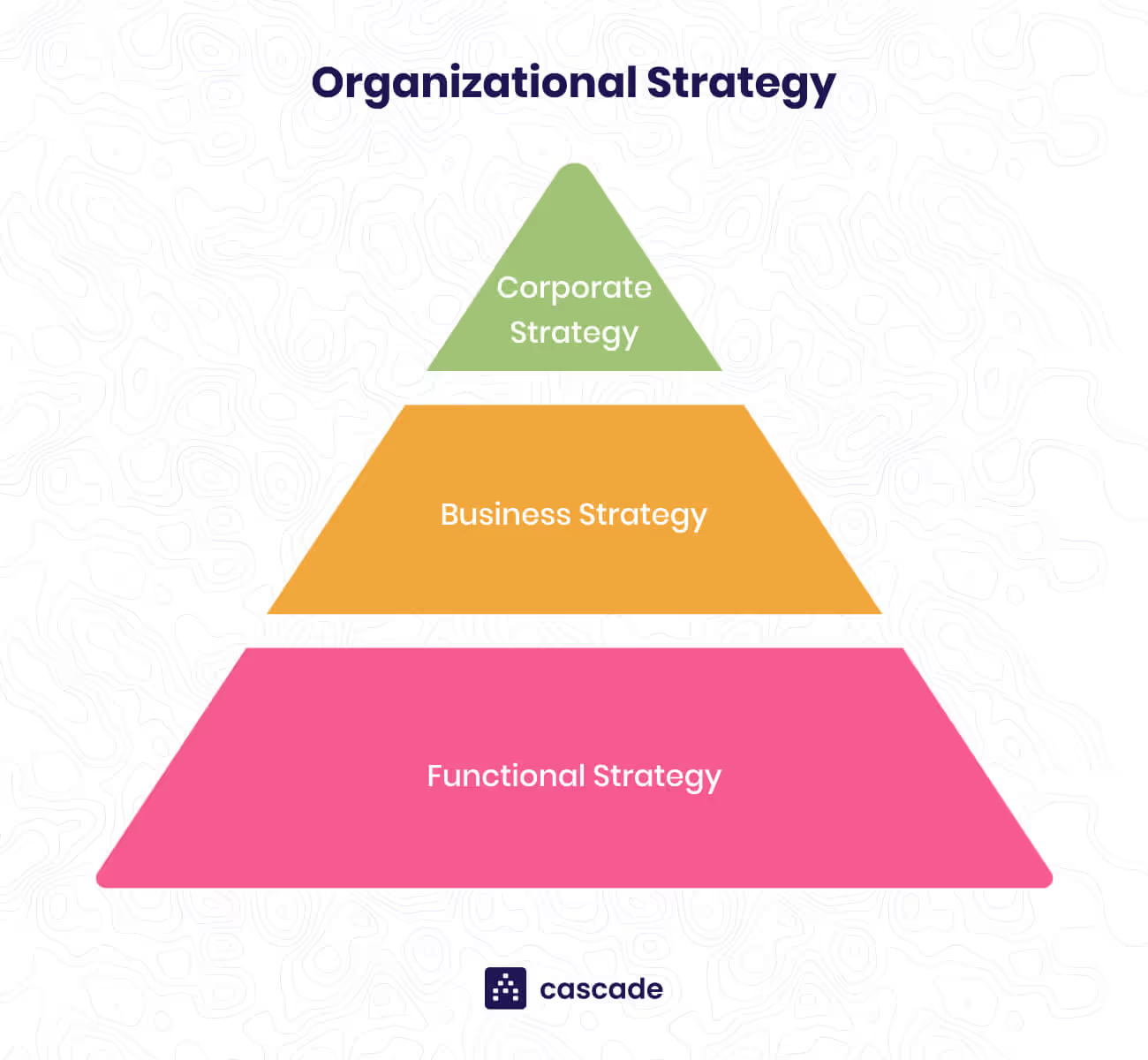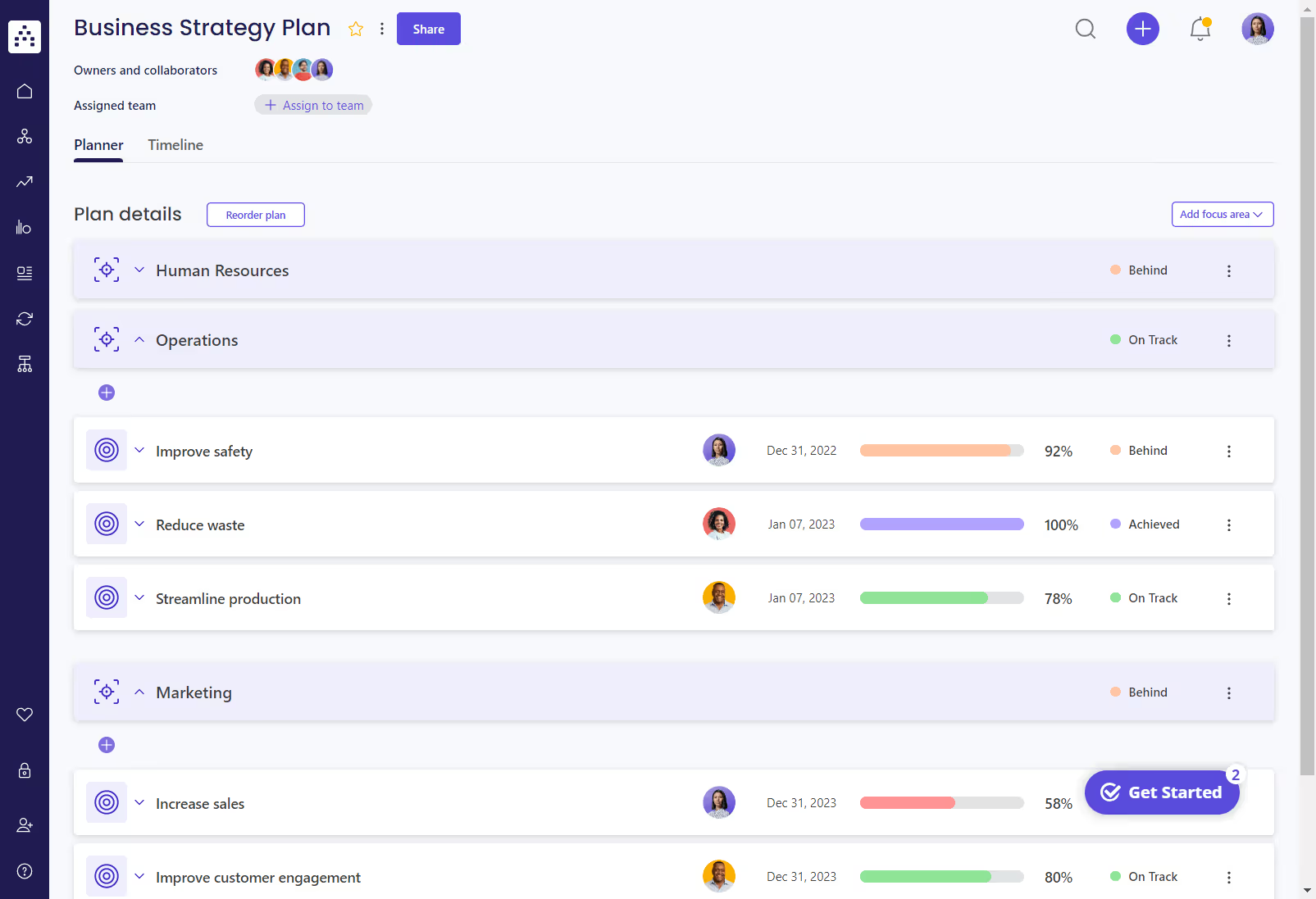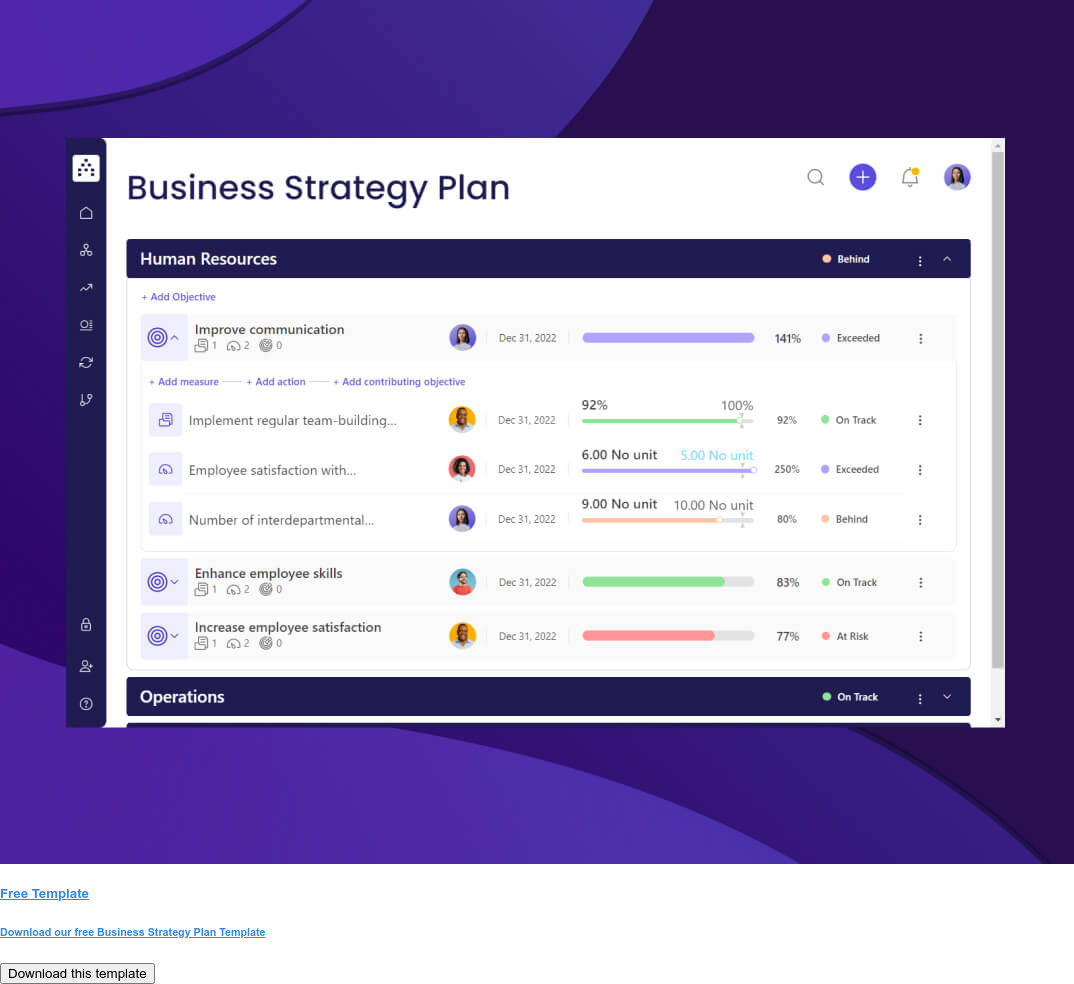Many leaders put a lot of effort into strategic planning, but their grand strategies fall short. More often than not, the issue lies not in the strategy they formulate, but in the strategy they overlook—the business level strategy.
This strategy concentrates on the execution of initiatives tailored specifically to a business unit. It's like “the middle level” of strategy and as it often happens with middle-level things, it remains overlooked in the shadow of the bigger picture.
Gartner’s survey shows that 67% of key functions at a company are not aligned with business units and corporate strategies. It also shows that 67% of employees do not understand their role when new growth initiatives are launched. These findings suggest that most companies focus primarily on their overarching, high-level strategies, neglecting how these strategies translate to lower levels and functions.
Thinking in terms of strategy levels is a good way of breaking down your overall strategy into manageable parts. This approach makes it easier to understand who's responsible for what and how the strategy should be carried out.
In this article, we'll walk you through the components of a strategy at a business level. We'll show you how to write a perfect strategic plan for your business and then apply it, ensuring all the pieces fit together seamlessly.
🎁BONUS: Download Your Strategy Levels eBook. It's a comprehensive guide that covers all three levels of strategy and will show you how to create both corporate and business strategies.
What Is A Business Level Strategy?
Business level strategy is a sum of the strategic planning and implementation activities that set and steer the direction of an individual business unit. These activities will generally include how to gain a competitive advantage and create customer value in the specific market the business unit operates in.
As a result, organizations with only one distinct business will often combine business strategy with corporate strategy as a single strategy level.

Benefits Of A Business Strategy
Before we dive deeper into business strategy, let's quickly discuss why you should have it regardless of your business model or company size. A well-defined business strategy:
- Provides a clear roadmap and purpose, guiding decision-making and resource allocation.
- Helps align the efforts of different departments and teams, fostering coordination and synergy.
- Enhances competitive advantage by identifying unique value propositions and differentiation opportunities.
- Aids in identifying and capitalizing on market opportunities while mitigating potential strategic risks.
- Improves organizational efficiency, promotes innovation, and enables effective measurement and performance evaluation.
Ultimately, a well-planned and executed business strategy can lead to sustainable growth, profitability, and long-term success.
Difference Between Corporate Level Strategy And Business Level Strategy
There seems to be a lot of confusion surrounding the difference between corporate level strategy and business level strategy, so let’s clear things up and get our definitions straight.
A corporate level strategy comes into play when an organization has multiple businesses operating in different markets. It sets the overall direction for the entire organization. It decides which markets to compete in, how to allocate resources across the organization, and similar big-picture things.
On the other hand, a business level strategy zooms in on a specific business within the organization. It focuses on creating a game plan tailored specifically for that business unit to achieve success in its corner of the market.
To reiterate, a corporate level strategy is about steering the entire organization, while a business level strategy is about guiding a specific business unit to thrive in its market.
To help make the difference between the two levels clearer, let’s look at the example of a bank below and how they use strategy levels in their organization.

Types Of Business Level Strategies With Examples
To better understand how business level strategy differs from other strategy levels, it’s useful to look at some business level strategy examples.
When organizations are deciding on the best strategy for a specific business level, they typically consider five types. Let's take a closer look at each of them and see what kind of competitive advantage they offer:
.avif)
Cost Leadership
A cost leadership strategy is all about offering products at a lower price than your competitors. To become cost leaders, businesses employ economies of scale and various tactics such as improving facilities, investing in tools, reducing overhead costs, and minimizing expenses related to R&D and POS operations. The ultimate goal is to achieve the lowest cost for your product or service.
Differentiation
Rather than focusing on lower costs and passing the savings onto customers, differentiation strategies emphasize the development and marketing of products in a manner that provides greater value to customers and focuses on unique features that warrant a higher price point.
The most famous example of differentiation is Apple, which applies this strategy across all business units (laptops, smartphones, tablets, etc.). Apple has heavily invested in R&D, customer service, and marketing, successfully carving a niche that allows them to charge a premium price for their products without compromising market share.
💡If you're considering pursuing a differentiation strategy, McKinsey's Three Horizons of Growth is a great framework to use.
Focused cost leadership
Businesses can concentrate their efforts by targeting a niche market or even a subset of that niche to further reduce costs.
For instance, a tool manufacturer might choose to focus their cost leadership strategy solely on the professional tradesperson market.
By narrowing their focus, companies can better understand their customers' needs and create value more efficiently.
Focused differentiation
A focused differentiation strategy involves standing out from competitors while concentrating efforts on a smaller subset of their customer base.
This might seem counterintuitive, but deeply understanding a smaller customer segment allows businesses to anticipate customers’ needs more accurately, making value creation a smoother process.
Integrated low-cost/differentiation
Some businesses find success by combining a low-cost strategy and differentiation.
A great example is the rise of "premium fast food" restaurants, which offer the low prices associated with traditional fast-food chains while providing a differentiated range of offerings. The combination provides just enough uniqueness to cater to a particular market. The success of such restaurants is a testament to the effectiveness of this type of strategy.
📚 If you're struggling to determine the best business strategy for your business unit, consider exploring the Value Disciplines framework. It has guided many successful businesses in the right direction.
How To Write A Business Level Strategic Plan
Once you've decided on the type of business strategy you want to pursue, you need to write a strategic plan that outlines the actions your business unit will take to achieve its vision.
If you need guidance on how to write a strategic plan, we've covered it in detail before. But it can’t hurt to quickly go over the process anyway.
1. Analyze where you currently stand
First, you need to gather and analyze key information about your business's present state and performance.
This can include reviewing KPIs, doing a SWOT analysis, evaluating the competitive landscape, reviewing financial performance, gathering customer feedback, considering internal capabilities, and analyzing risks and challenges.
Such an analysis will help you develop a fact-based understanding of your current position that should your strategic direction and choices.
2. Prioritize focus areas
Identify the key areas you'll be focusing on when working towards your vision. Your analysis from the previous step should help. These focus areas should be more specific than your vision statement, but not as detailed as having particular metrics or deadlines attached to them.
3. Define strategic objectives
Strategic objectives represent what you want to accomplish. These objectives are relatively high-level but should still have a deadline associated with them. Make sure your strategic objectives align with one or more of your focus areas. Typically, you'll have 3-6 objectives for each focus area.
4. Assign KPIs
KPIs are values that help you measure progress toward your strategic objectives. It's important to develop KPIs that directly contribute to achieving specific goals or objectives. Otherwise, you run the risk of diverting attention, time, and resources away from crucial KPIs.
5. Create projects
Projects describe what you will do to accomplish your objectives. Projects need to be specific, including clear deadlines and a description of the actions you'll take.
Each project should align with at least one strategic objective and outline how it will contribute to achieving that objective. Typically, you'll have multiple projects for each strategic objective.
💡Pro tip: When writing your strategic plan, it’s helpful to keep in mind that business level strategy decisions are typically based on analyzing two main factors: customers and core competencies.
👉How Cascade can help:
Cascade’s Planner makes it easier to create, share and execute strategic plans. To make things even simpler, you can use our template which will help break down your high-level plan into executable outcomes.

👉🏻 Get your free business strategy template here.
More related business level strategy templates:
- Business Growth Strategy Template
- Business Development Strategy Template
- Business Continuity Plan Template
- Business Expansion Plan Template
- Business Action Plan Template
💡Don't see what you're looking for? Explore our strategy template library with over 1,000 templates catered to different business units and industries.
The Key Focus Areas For Business Level Strategies
Now that we understand how to structure a business strategy, let's dive into the actual content that should be included.
While the specifics will vary depending on the organization, there are generally two key elements that should be addressed in your business level strategy.
Core Competencies
In business level strategy, the concept of core competencies is key.
Core competencies are the unique elements of a business that set it apart in the market and provide value to customers.
Identifying and leveraging these competencies to gain a competitive advantage is a major aspect of business level strategy.
If you're struggling to identify your business's core competencies or competitive advantages, a VRIO analysis is a great starting point that should help you out.
👉 Grab your free VRIO strategy template here.
Customers
Understanding your customers is another essential aspect of business level strategy.
You need to know who your current and potential customers are and how they interact with your business.
To develop this understanding, consider the following who, what, and how questions:
Who are the customers?
Look at demographic descriptors and consumption patterns to paint a clear picture of your customer base.
Unlike corporate strategists, business level strategists often have a precise understanding of their customers. That allows them to tailor strategic decisions in a way that just isn’t feasible at a corporate level.
What are the products that customers need?
Understanding the wants and needs of your customers is vital for developing and maintaining a competitive advantage.
Successful businesses are the ones that fulfill customer needs and create value. That’s why you want to understand your target customers to the point where you can forecast changes in customer needs as well as anticipate fluctuations in demand.
How can the business satisfy customer needs?
Finally, organizations need to leverage core competencies, resources, and their understanding of their target audience to ensure customer satisfaction. Businesses need to create a solution to a pressing problem and create a product or service that’s perceived as valuable in the eyes of the target market segment.
Putting it all together
Now that you have a solid understanding of your core competencies and the customers you serve, you have a powerful foundation for developing strategies that foster competitive advantage and drive value. This is the ultimate goal of the business level strategy.
How To Cascade Business Level Strategy To Functional Level Strategy
Once you've crafted your business strategy, it's important to ensure that it’s effectively communicated and translated into actionable plans at the functional level.
This process, known as cascading, enables each department to align its efforts with the overall strategic objectives of the organization. Here’s how you do it:
- Share the business level strategy with department heads.
- Identify relevant objectives and projects for each department.
- Define focus areas based on the identified objectives and projects.
- Develop department-specific strategies and tactics. Address specific actions each department will take.
- Align efforts and coordinate among departments.
By following these steps, you can effectively cascade your business strategy to all key departments, coordinate efforts and achieve strategic objectives.
👉How Cascade can help:
With Cascade's Alignment & Relationships feature, you can see every plan in your workspace and how they connect to each other from a bird's eye view. Using a simple tree structure, you'll be able to see how every plan is aligned with each other and progressing across your organization.
%20(1).png)
Final Thoughts
Business level strategy is where abstract strategic directions from the corporate level translate into tangible initiatives that generate real-world value.
Together with a strategy execution platform like Cascade, it can help you achieve great strategic feats. The combination of the right approach and the right software empowers you to:
- Create simple yet impactful strategies
Our most successful customers have used Cascade to zoom in on certain parts of their business, identify their core competencies, and prepare suitable objectives. Instead of overcomplicating strategies, they kept it simple and actionable.
- Reverse engineer your strategy
Cascade enables you to see where your initiatives stand today and provides data as well as the wider context. These strategic insights will help you design metric-based strategies rooted in reality, rather than relying on disconnected numbers, outdated tactics, and irrelevant industry benchmarks.
- Adapt quickly and effectively
You can monitor the impact of a particular approach on a smaller, business level scale, recognize what’s working, and either change course or double down.
These benefits and everything mentioned in the article make a business level strategy combined with a strategy execution platform immensely valuable. Good and iterative strategic planning at the business level will radically impact outcomes for any organization—from the very small right up to the very large one.
Business Level Strategy FAQs
Should a business level strategy change over time? If so, why?
Yes, business level strategies should change over time to adapt to evolving markets, competition, customer needs, and internal capabilities.
The ability to adapt also reflects that the business is monitoring its current performance, the impact of its strategic decisions, and is proactively thinking about improvements. The ability to adapt is crucial for sustainable success.




.avif)

.png)
.jpg)
.jpg)
%20(1)%20(1)%20(1)%20(1)%20(1).png)



